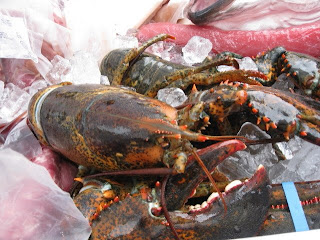 The New London Farmers market is extra special to me.
The New London Farmers market is extra special to me. Just a short walk from my house, it was both the first farmers market I frequented and the first market to accept me as a vendor. I probably wouldn't have become a soapmaker if this market didn't exist.
And yet, I have to admit that this market--like New London itself--is always struggling, never quite thriving. It's a small market with few vendors. Some years we've had fish and some


years we've had eggs, but most often we've had just four farmers and myself. The produce has always been top notch and surprisingly varied: along with staples like tomatoes and corn, you can find okra, cilantro, raspberries, kale. But there's no bread, no meat, no dairy, no street food. With so few vendors, we haven't had much budget for promoting the market. And with little promotion, the market hasn't attracted enough customers to retain many vendors. So it hasn't exactly been one-stop shopping.
Until this year.

This year the New London Farmers market relocated to the parking lot of Fiddleheads Natural Foods Co-op. Although we still don't have the range of vendors that other markets enjoy, now our customers can buy produce with us, then finish their shopping in the co-op. Local and raw milk, cheese, bread, meat, bulk items, coffee, olives, even gingery pickled carrots--between the farmers market and Fiddleheads, our customers may not need to visit a conventional supermarket all summer.
How do the customers feel about it? Well, I'm a customer and I love it. The market runs Tuesdays and Fridays but I only vend here on Fridays. So Tuesdays, 10 a.m. sharp, I'm here with my market bags, buying as much produce as I can fit in the fridge, then going into Fiddleheads to

buy staples like nuts and seeds, as well as produce like avocados or bananas that can't be grown locally. (Fiddleheads also has local produce, but I want to support my fellow vendors on market days.)
I admit, I'm biased. I joined the co-op before it

opened and used to serve on the Board of

Directors. So of course I'm thrilled that my market and my co-op have teamed up. But is anyone else?
Yes! I say that with confidence because today I got to see the market through fresh eyes. My friend Anna, who'd never been to the New London Farmers market and had only briefly seen the inside of the co-op, met me outside Fiddleheads this morning for the grand tour. She had such a smile on her face buying her carrots and blueberries. She hadn't eaten breakfast, though, so we quickly went inside the co-op for a little nosh and conversation. (I love that the co-op has a few booths by the window. One thing our farmers market has lacked is a place for friends to sit and chat.)

After breakfast, we bought dates, avocados, almonds, cheese...then went back out for a little more produce. As Anna was buying peaches, she turned to me and said, "I'm so happy! This is the way we shopped when I was growing up in Italy!" Best of all, just before she drove away she said, "Can we do this every week?"





























